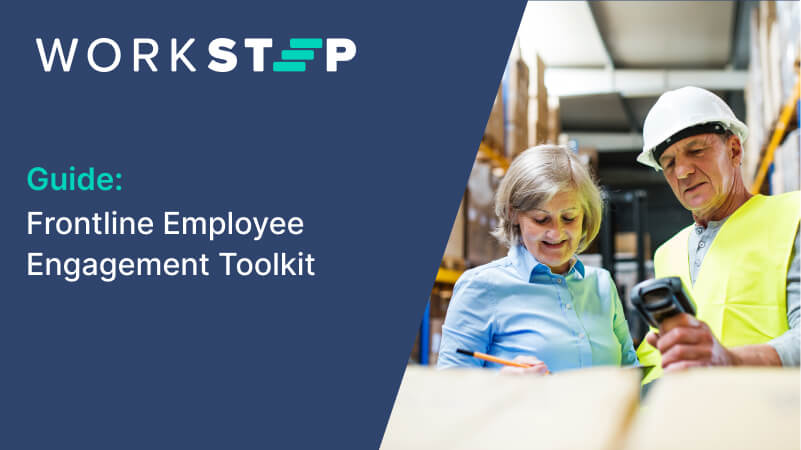Understanding the impact and signs of low frontline employee engagement
September 22, 2023
Your frontline employees are perhaps the single most important cohort of people within your organization. Yes, even more important than C-suite leadership teams making sweeping decisions from their home office. When this segment of employees feels disengaged, the ripple effect can harm an organization’s productivity, safety protocols, and bottom line.
Frontline employees operate as the backbone of many organizations. Spanning industries such as retail, hospitality, manufacturing, and logistics, they are the ambassadors of the brand and the most frequent touchpoint for customers. Their energy, commitment, and satisfaction have profound implications for business success. So why then do many leaders overlook the signs of low frontline employee engagement?
In this blog, we will discuss how lackluster frontline employee engagement is a multi-fold issue that directly contributes to poor customer satisfaction, failed KPIs, and missed opportunities. Moreover, how a disengaged workforce can harm an organization’s overall productivity, safety standards, and profitability. We’ll also discuss what to look out for and how to improve your employee experience.
The 5 signs of low frontline employee engagement
Low engagement is no joke. A staggering 80% of deskless workers report a lack of communication with their employers, with only 56% feeling genuinely connected to their respective organizations. This leads to an environment where 41% of retail and hospitality employees alone report that they hardly ever look forward to clocking in for their shift.
1. Diminished interaction with internal communications
If frontline workers, especially those who don’t have a dedicated company email address, seldom engage with internal communications – whether it’s a company newsletter, intranet updates, or team announcements – it’s a warning sign. These interactions give employees a sense of belonging and relevance within the company. However, a significant portion of frontline workers often feel left out of the loop and that their voice can’t make an impact.
2. Elevated absenteeism
Frequent absenteeism isn’t just about personal issues or health; it’s often a red flag for disengagement. High absentee rates, especially in industries like retail and hospitality, point to deeper engagement issues. Engaged employees look forward to their jobs and contribute actively whenever able. Look for patterns in your employee’s usage of accrued time off or sick days. If an employee’s PTO balance is perpetually at 0 hours, they are telling you that they will take any opportunity to avoid being at work. This is a great chance to help identify and solve for any pain points they might have.
3. Resistance to new technologies
An organization’s growth is closely tied to its adaptability. When new technologies are introduced, they aim to streamline processes and enhance efficiency. Employees motivated to excel in their roles often welcome tools and technologies that can make their jobs easier. However, a reluctance to adopt these tools often indicates deeper issues. A hesitance or outright refusal to embrace new tools often indicates disengagement or a lack of faith in the organization’s direction. An employee may also have the opinion that they don’t need to invest the time to learn a new tool if they don’t plan to stay at the organization much longer.
4. Drop in productivity
Engaged employees are known to be more productive and make fewer errors. A noticeable drop in an employee’s output, coupled with an increase in mistakes, suggests declining engagement. Engaged employees take pride in their work, ensuring tasks are completed efficiently and accurately. Conversely, a stark decrease in output and a rise in errors often point towards declining engagement. If a star-employee suddenly behaves as if they are on auto-pilot, there is a great chance that they are mentally disengaged from their work, burnt out, or frustrated with some aspect of their role.
5. Surging turnover rates
Perhaps the most telling sign is when employees start leaving the company in droves. The costs associated with rehiring and retraining can be substantial, impacting the business’s profitability. Rehiring and retraining consume significant resources, directly impacting an organization’s financial health and operational continuity. Additionally, there tends to be a sort of “hive mentality,” amongst frontline populations where negative sentiment can fester, leading to waves of great workers leaving for what they perceive to be a better opportunity simply because one small group felt that way.
The 3 E’s of employee engagement
The 3 E’s of employee engagement model captures a holistic approach to building a culture of excellence and sustainability within an organization. Let’s break down these three facets:
1. Empowerment
Employees need to feel that their roles are significant to the company’s success. By offering responsibilities that match their skill set, and providing them with the necessary tools and training, organizations can instill a sense of importance in their roles. Create channels for employees to voice out their opinions, concerns, and suggestions. Regular feedback sessions and an open-door policy can help in achieving this. Encourage employees to be part of the solution, not just passive participants.
2. Energized
Motivation is an intrinsic component of employee engagement. Incorporate training programs, mentorship schemes, and workshops that help employees connect their day-to-day roles with the bigger picture of the company. Recognize and reward efforts that go above and beyond. Gamification, personal goal tracking, and creating an atmosphere of friendly competition can energize employees.
3. Enabled
Employees need the right tools and environment to flourish. Invest in efficient, user-friendly software and technology. Regular training sessions ensure that all staff are comfortable using these tools. Cut down on obsolete systems and processes that slow down productivity. Paperwork should be minimized, and digital processes should be embraced.
There are a few ways to build upon this model. While it is essential to empower employees, organizations should also have a mechanism to continually gather feedback, analyze it, and implement necessary changes. This ensures that the engagement strategies stay relevant and effective. Energizing employees doesn’t only relate to work-related aspects. Mental and physical well-being programs can significantly contribute to overall energy and motivation.
To ensure that employees are enabled, training and development should be customized to fit individual needs, which ensures that each employee can utilize their potential fully. Encourage cross-departmental collaborations. This not only fosters a culture of teamwork but also provides an opportunity for employees to learn and understand different facets of the business. Employees should be clear about the company’s long-term and short-term objectives and have some scope into how other departments operate. This alignment ensures that every individual is working towards a common goal.
Evolving from employee engagement to employee enablement
Employee enablement encompasses a broader framework. It focuses on providing employees with the resources, tools, and environment they need to work efficiently and effectively. It’s not just about the emotional and rational commitment they have to the organization, but also about their ability to perform their role to the best of their potential. While engagement is about creating an emotional connection, enablement is about physical and practical empowerment. It’s the evolution of employee engagement, marking the transition from just feeling good about the job to actually excelling at it.
While it is essential to empower employees, organizations should also have a mechanism to continually gather feedback, analyze it, and implement necessary changes. This ensures that the engagement strategies stay relevant and effective. Energizing employees doesn’t only relate to work-related aspects. Mental and physical well-being programs can significantly contribute to overall energy and motivation. To ensure that employees are enabled, training and development should be customized to fit individual needs, which ensures that each employee can utilize their potential fully. Encourage cross-departmental collaborations. This not only fosters a culture of teamwork but also provides an opportunity for employees to learn and understand different facets of the business.
Employees should be clear about the company’s long-term and short-term objectives and have some scope into how other departments operate. This alignment ensures that every individual is working towards a common goal. Engaging frontline employees is paramount, from ensuring smooth operations in the supply chain to delivering exceptional customer experiences in retail. This engagement plays a crucial role in customer satisfaction and, by extension, the overall success of a business. Positive business outcomes of engaged employees extend beyond reducing turnover. It leads to enhanced productivity, fewer safety incidents, and reduced absenteeism.
Recognizing the signs of low engagement early, and taking proactive measures centered around empowerment, encouragement, and enrichment, can transform an organization, creating a motivated, efficient, and loyal workforce poised to drive it towards a brighter future.
Tune into your frontline with WorkStep
With the frontline employee engagement platform that delivers the real-time insights you need to take action, retain your workforce, and drive your business forward.
Tom Goyette, Product Marketing Manager | tom.goyette@workstep.com
Tom Goyette is a Product Marketing Manager at WorkStep. With experience in start-up and enterprise level SaaS and eCommerce organizations, Tom excels at managing and creating content, marketing, and analytics. Tom believes people are at the center of every great organization and is eager to share stories that highlights the value of the employee voice.



